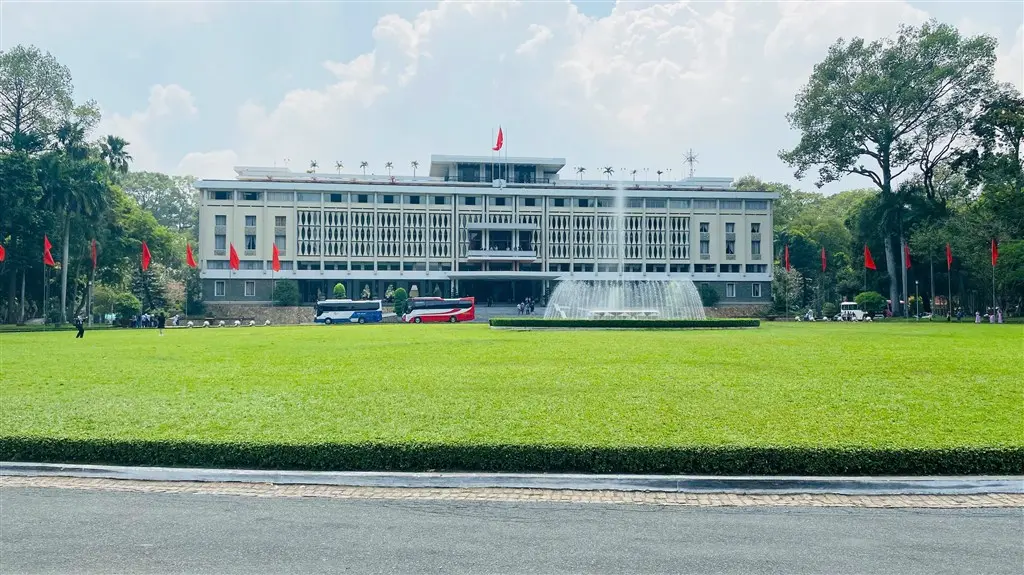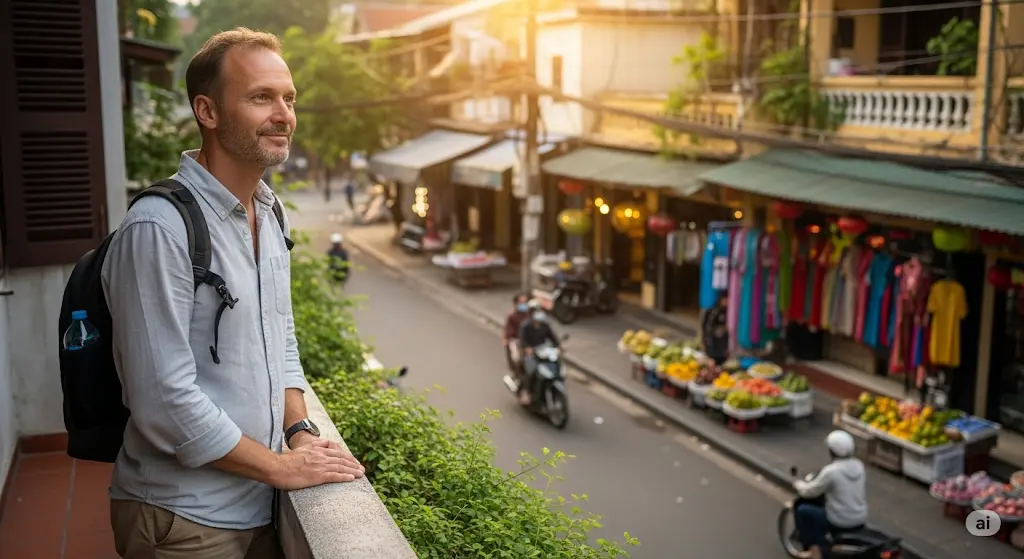Welcome to Vietnam. This nation offers a captivating journey for all senses. Your taste buds are set for a remarkable experience. EssentialVietNamtravel.com is your dedicated guide. We want to help you explore the vibrant world of Vietnamese gastronomy. This journey is more than eating. It is about understanding a culture through its food. Prepare for a foodie vietnam experience that will create lasting memories.
This guide provides detailed, practical steps. Anyone can use it to discover the best of Vietnamese cuisine. We aim for you to achieve 90% of your culinary goals with this information. Your food trip vietnam starts now. Authentic experiences are valuable, and this guide will lead you to them. The country’s Food culture is rich and inviting. Culinary tourism here is a growing field, attracting many.
Understanding Vietnamese Cuisine: Foundations for Your Adventure

Vietnamese cuisine captivates with complex flavors from simple, fresh ingredients. Understanding its core principles is key for any foodie vietnam. This knowledge elevates appreciation. It transforms eating into cultural immersion. The Food culture in Vietnam is deep. It reflects history, geography, and daily life. EssentialVietNamtravel.com believes a true Vietnam culinary explorer seeks this understanding.
It is not just tasting. It is connecting with Vietnam’s soul. Many find Vietnamese food is delicious. This section explores why. We cover philosophy, key ingredients, and regional variations. These make Vietnamese cuisine unique. This foundation enriches every meal in Vietnam. It turns your journey into an authentic experience. Local knowledge enhances food discovery. This understanding helps you find food recommendations and plan culinary travel effectively. This knowledge is essential for anyone wanting to learn about Vietnamese food culture.
The Philosophy: Balance, Freshness, and Five Flavors
Vietnamese cooking centers on a core philosophy. This philosophy is the balance of five flavors: spicy, sour, bitter, salty, and sweet. Each Vietnamese Dish strives for this harmony. This balance makes food exciting. It keeps the palate engaged. Freshness is equally vital. Vietnamese cuisine relies heavily on fresh herbs usage. Plates piled with mint, cilantro, basil, and perilla are common.
These are not mere garnishes. They are integral components. They add aroma, texture, and flavor. This commitment to freshness implication means Ingredient sourcing often happens daily from Local markets. This ensures peak flavor. The culinary indifferent might miss this. A true foodie vietnam appreciates the vibrant taste from just-picked produce. This emphasis on fresh, high-quality components defines the Dining experience.
It makes food light yet satisfying. This balance of five flavors is a hallmark of Southeast Asian cuisine and crucial to Vietnamese gastronomy. Understanding this helps you appreciate Presentation and the artisanal approach in many kitchens.
Key Ingredients and Exciting Regional Culinary Diversity
Several key ingredients form Vietnamese gastronomy’s backbone. Rice, in many forms, is central. You find steamed grains, delicate Rice Noodles (like in a Pho bowl), and translucent Rice Paper for Goi Cuon (Spring rolls). Fish sauce, or Nuoc Mam, is another cornerstone. This Fermented Fish product provides deep, savory umami. Its Base is fermented fish. It is used in marinades, dipping sauces, and as a condiment.
Do not fear its aroma. It transforms with other ingredients. Fresh herbs are crucial. Lemongrass, ginger, garlic, and chilies add layers. These create the Vietnamese food profile: fresh, Aromatic, Flavorful. Vietnam’s geography shapes its cuisine. There are distinct Regional specialties. North Vietnam, with Hanoi, offers refined, subtle flavors. Food is less spicy. Famous dishes include Pho and Bun Cha.
Central Vietnam (Hue, Da Nang) has imperial cuisine. Dishes are intricate, often spicy. Look for unique street food Da Nang options like Mi Quang or Cao Lau in Hoi An, with its Unique Ingredient, Ash-Lye Water Noodles. South Vietnam (Ho Chi Minh City) features bolder, sweeter flavors. The Mekong Delta’s abundance influences cuisine here with more coconut milk and sugarcane. This Regional culinary diversity means a foodie vietnam can explore varied tastes across the country, from Historical recipes to modern interpretations.
Iconic Vietnamese Dishes Every Foodie Vietnam Must Try
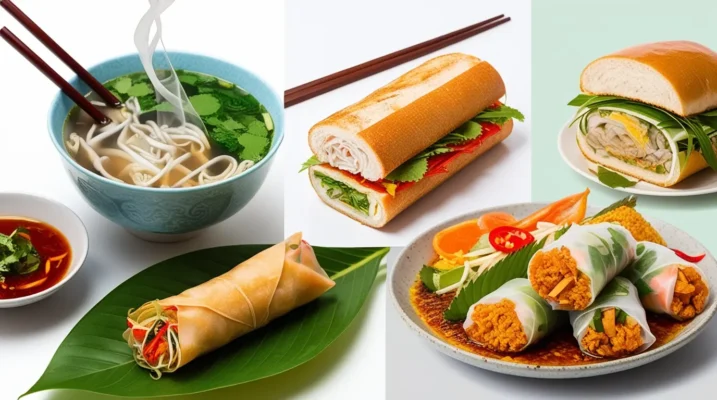
Your culinary journey through Vietnam is incomplete without tasting its iconic dishes. These tastes define Vietnamese food globally. Each dish tells a story of tradition, local ingredients, and Vietnamese culinary ingenuity. EssentialVietNamtravel.com encourages every visitor, from the fast food enthusiast to the Gourmet Vietnam seeker, to try these essentials. These dishes are found at humble Street food stall locations and renowned Restaurants.
They represent Vietnamese cuisine’s heart. Trying new food is adventurous. This list guides you to rewarding culinary experiences. We provide details to appreciate each bite. You learn what makes them special. This ensures you are not just eating, but experiencing authentic flavors. This is what being a foodie vietnam is about. These dishes are a cornerstone of any food trip vietnam. Many consider these part of the best Vietnamese food experiences. Figures like Anthony Bourdain and Luke Nguyen have highlighted many of these treasures.
Pho and Bun Cha: Beloved Noodle Soups and Grilled Pork
Pho is perhaps Vietnam’s most famous export. It is a fragrant noodle soup. The broth is its soul, simmered for hours with beef or chicken bones and Vietnamese Spices like star anise. Rice Noodles, tender meat, and fresh herbs complete the Pho bowl. Finding the best pho in Hanoi old quarter is a popular quest. Each Region, and vendor, has a slightly different recipe. Accompaniments include lime, chili, and basil.
Eating Pho is a ritual. It is comfort food. A true foodie vietnam seeks different versions. Bun Cha is a quintessential Hanoi dish. It features grilled pork patties and pork belly. These are Served With a bowl of diluted, sweetened Fish sauce with pickled papaya. Alongside, you get fresh rice vermicelli and a generous Herb Platter, often including mint. To eat, dip noodles and herbs into the broth with the Grilled Pork. The smoky flavor, tangy broth, and fresh herbs create an unforgettable taste. This Dining Style is characteristic and communal. Both Pho and Bun Cha are staples in North Vietnam.
Banh Mi and Goi Cuon: Sandwiches and Fresh Rolls
Banh Mi is a delicious example of French influence meeting Vietnamese flavors. It starts with a light, airy Vietnamese baguette. The Key Feature is its thin, crispy crust. Inside is a symphony of textures and tastes. Common fillings include various pork types, cilantro, cucumber, pickled carrots, and daikon. A smear of mayonnaise or chili sauce completes it. Banh Mi is popular Street food.
Vendors are on almost every corner in Hanoi and Ho Chi Minh City. It is quick, affordable, and satisfying. A foodie vietnam appreciates the contrast of warm bread, savory meats, and fresh vegetables. Even a Western food purist might love this. Goi Cuon, or fresh Spring rolls, are lighter. Cooked shrimp, pork, vermicelli, lettuce, and herbs are wrapped in delicate Rice Paper. The Wrapper, rice paper, is key.
They are served with hoisin-peanut or nuoc cham dipping sauce. Goi Cuon showcase freshness. They are a perfect example of fresh herbs usage and balance. These are great appetizers or light meals. Both Banh mi and Goi Cuon are easily found and represent different facets of daily Vietnamese food.
Com Tam and Other Notable Dishes: Rice and Regional Stars
Com Tam, or broken rice, is popular in South Vietnam. It originated from using fractured rice grains. Today, it is a beloved staple. A Com Tam plate includes grilled pork chop, steamed egg meatloaf (cha trung), shredded pork skin (bi), and often a fried egg. It is served with pickled vegetables and nuoc cham. The broken rice has a unique texture. It is hearty and affordable.
A foodie vietnam appreciates its rustic charm. Cha Ca La Vong is another famous dish, especially in its City of Origin, Hanoi. This involves grilled fish with turmeric and dill. Cao Lau from Hoi An is unique due to its Ash-Lye Water Noodles. These dishes highlight Regional specialties. Exploring them helps understand Culinary travel in Vietnam. Many restaurants, from street stalls to casual eateries, serve excellent Com Tam. The Michelin Guide Vietnam has started recognizing places serving such iconic dishes, elevating their status. Discover recipes for these at a Cooking Class. Learning about the Main Ingredient in each dish enhances appreciation.
The Ultimate Foodie Vietnam Street Food Experience
No foodie vietnam journey is complete without diving into the vibrant Street food scene. This is where Vietnamese culinary culture truly beats. Street food stalls line sidewalks, offering affordable, delicious, Authentic dishes. From steaming noodles to savory pancakes and sweet desserts, variety is astounding. EssentialVietNamtravel.com believes exploring street food is one of the most exciting ways to connect with local life. It is an adventure for the senses. You will see, smell, and taste new things.
This section guides navigating this bustling world: choosing stalls, ordering, and enjoying safely. We highlight street food hubs in major cities. Prepare for the ingenuity of Vietnam’s street food vendors. This is where you find authentic experiences. Scene exploration is part of the fun. The Street food culture here is a major Culinary Highlight. Many vendors operate from a Sidewalk Stall.
Navigating Street Food Stalls and Safety First
Eating at a Street food stall in Vietnam is an experience. Look for popular stalls. A local crowd is a good sign. It means food is fresh and tasty. Observe hygiene. Does the vendor keep their area clean? Are ingredients covered? Use judgment. Ordering can be simple. Many stalls specialize. Pointing works. Learn basic Vietnamese food phrases. You often sit on small plastic stools. This is part of the charm. Using Chopsticks is common. Embrace the atmosphere. It is lively. While street food is generally safe, take precautions. Always choose busy stalls with high turnover.
This suggests fresh cooking. Observe vendor hygiene. Look for clean surfaces. Drink bottled water. Be cautious with ice unless sure it is purified. Carry hand sanitizer. These steps ensure your foodie vietnam street food adventure is memorable for the right reasons. Local knowledge enhances food discovery. Authentic experiences are valuable, but so is health. You might see vendors in a Non La.
Hanoi and Ho Chi Minh City: Bustling Street Food Hotspots
Hanoi, particularly its Old Quarter, is a paradise for Street food lovers. Narrow streets pack vendors. Each offers a specialty. Stroll Ta Hien Street or Dong Xuan Market. Find Pho, Bun Cha, Banh Mi, Banh Cuon. Egg coffee (Ca Phe Trung) is a Hanoi specialty. Many Vietnamese food blogger Niche Vietnamese Street Food specialists focus on Hanoi. The best pho in Hanoi old quarter is a common quest. Ho Chi Minh City (Saigon) has an equally vibrant, though more sprawling, street food scene. District 1 and District 4 are popular.
Find Southern Vietnamese specialties like Com Tam, Hu Tieu, and Banh Xeo. Seafood street food is popular. Night markets like Ben Thanh offer choices. Exploring by motorbike on a food tour Ho Chi Minh City discovers hidden spots. The energy of Saigon’s street food is infectious. It is a melting pot reflecting the city’s character. Both Hanoi and Ho Chi Minh City offer incredible diversity for Culinary tourism.
Da Nang, Hoi An, and Other Regional Street Food Finds
Central Vietnam boasts unique Street food. Da Nang and Hoi An are culinary hotspots. In Da Nang, seek unique street food Da Nang options like Mi Quang and Banh Trang Cuon Thit Heo. Seafood is fresh. Hoi An, an ancient town, is famous for Cao Lau. This dish features special noodles. White Rose dumplings (Banh Bao Vac) are another Hoi An specialty. The night market in Hoi An is great for local treats. Beyond these, other regions offer gems.
A food tour Mekong Delta reveals rural delights, often simpler but incredibly Flavorful. Look for insect-based snacks in some areas if you are adventurous. Local markets everywhere are a source of street snacks. This Regional culinary diversity in street food makes a food trip vietnam endlessly exciting. Each Location offers something new for the Vietnam food enthusiast. Authenticity seeking often leads to these less-trodden paths.
Beyond Street Food: Restaurants and Dining Experiences in Vietnam
While street food offers an unparalleled grassroots foodie vietnam experience, Vietnam’s culinary landscape extends beyond sidewalks. The country boasts diverse Restaurants. These cater to every taste and budget. Find humble local eateries serving traditional dishes. Sophisticated establishments recognized by the Michelin Guide Vietnam also exist. EssentialVietNamtravel.com encourages exploring this spectrum.
Dining in restaurants provides a different atmosphere. Try more complex dishes or enjoy a leisurely meal. Understanding Vietnamese dining etiquette enhances these experiences. This section guides through restaurant types. We discuss finding authentic spots. Whether a Vietnamese cuisine lover or curious traveler, the restaurant scene offers delights. Discovering diverse dining experiences is part of culinary travel joy. Many places offer an excellent Dining experience focusing on Regional specialties and Fresh ingredients.
Types of Restaurants and Finding Authentic Vietnamese Food
Vietnamese restaurants vary greatly. “Quan com binh dan” are local eateries serving affordable, everyday meals, often with pre-cooked dishes. These are great for an Authentic, budget-friendly experience. Mid-range restaurants offer wider menus, often specializing in Regional Cuisine or dishes like Cha Ca La Vong. Fine dining options grow, especially in Hanoi and Ho Chi Minh City. Some offer modern interpretations. Others focus on high-quality traditional Historical recipes. The Michelin Guide Vietnam now recognizes several. A foodie vietnam can find a 5 stars Vietnamese Restaurant experience.
Finding authentic restaurants involves looking for places popular with locals. Venture from tourist areas. Menus mainly in Vietnamese can be a good sign. Observe Fresh herbs usage. Ask for recommendations for authentic local food. Restaurant reviews from a Food Blogger focused on local gems can help. Authenticity seeking is rewarded with true Vietnamese gastronomy.
Vietnamese Dining Etiquette and the Overall Experience
Vietnamese dining is often communal. Dishes are placed centrally for everyone to share. Use serving spoons. It is polite to try everything. Hold your rice bowl close when eating with Chopsticks. Do not stick chopsticks upright in your rice bowl. This resembles incense and is a funeral taboo. Wait for elders to start eating first. Sharing food is cultural. It fosters connection. If invited to a home, a small gift like fruit is appreciated.
This understanding shows respect. It enriches your Dining experience. The Presentation of food can range from simple to artistic. Even in casual settings, care is taken. The focus is on fresh, Flavorful food. The overall experience should be enjoyable and an opportunity for Local interaction. Many restaurants aim to provide an Authentic experience, reflecting Vietnamese culture. Learning about food history enhances this.
Immersive Culinary Adventures for the Dedicated Foodie Vietnam
For the dedicated foodie vietnam, tasting is just the beginning. Immersing in culinary culture offers deeper understanding. Vietnam provides numerous opportunities. Learn to cook favorite dishes. Take guided food tours. Explore vibrant Local markets where Ingredient sourcing happens. EssentialVietNamtravel.com highly recommends these activities. They transform you from passive consumer to active participant.
These adventures allow Local interaction. They provide insights into Cooking techniques and Food history. This section explores ways to dive deeper into Vietnamese gastronomy. Prepare to engage with Food culture on a new level. These experiences create lasting memories and skills. Find food recommendations for these from trusted sources. This helps Plan culinary travel for a richer experience. Trying new food is adventurous, and these activities amplify that.
Vietnamese Cooking Classes: Learning Culinary Techniques
Joining a Vietnamese cooking class is a fantastic way to learn. Many classes are in tourist hubs like Hoi An, Hanoi, and Ho Chi Minh City. A Vietnamese cooking class Ho Chi Minh City might Focus on Southern flavors. Others specialize in imperial cuisine or Vegetarian Vietnamese recipes. Typically, a class includes a market tour. You learn about fresh produce and local ingredients.
Then, under a chef’s guidance, you prepare several dishes. You learn the balance of five flavors. You practice specific Cooking techniques. Finally, enjoy the meal you cooked. This hands-on experience is invaluable. You take home Recipes and deeper understanding. It is fun and educational for any foodie vietnam. Many classes focus on Regional Cuisine. This is a great way to Discover recipes. The focus is on artisanal skills and understanding the Main Ingredient.
Food Tours and Local Market Exploration: Deep Dives
Food tours offer a curated way to explore Vietnam’s culinary scene. Led by knowledgeable local guides, these tours take you to hidden gems. They introduce dishes you might not find alone. Some focus on Street food. Others explore neighborhoods or markets. A food tour Mekong Delta offers a unique perspective on rural cuisine. Guides share Food history and culture. They help navigate menus. This is excellent if time is limited, or for a non-adventurous eater wanting a guided introduction. A good Food Tour provides Authentic experiences.
Exploring Local markets is essential for any foodie vietnam. These markets are vibrant. They are where chefs and home cooks source fresh ingredients. See an array of fruits, vegetables, herbs, meats, seafood. Local Market Offers a glimpse into daily life. It is great for Food photography. Observe Ingredient sourcing firsthand. Engage with vendors. Scene exploration in markets provides appreciation for freshness in Vietnamese cuisine.
Vietnamese Coffee Culture: An Essential Foodie Vietnam Ritual
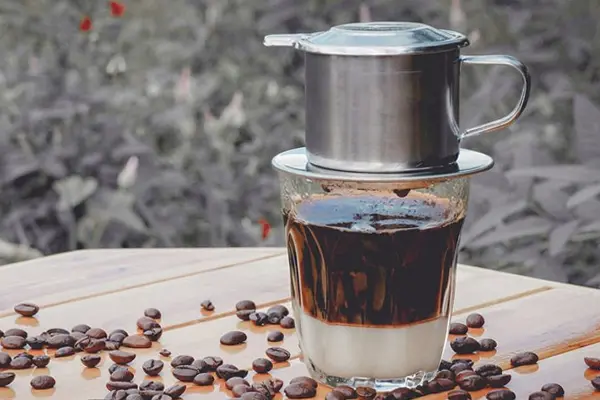
No foodie vietnam experience is complete without delving into Vietnam’s unique Coffee culture. Vietnam is a major coffee producer. Coffee is more than a beverage; it is a way of life. Cafes are social hubs for meeting, working, or watching life. EssentialVietNamtravel.com insists you savor Vietnamese coffee. Its Preparation and taste are distinct. Understanding its story and local enjoyment enriches your journey.
From the traditional Phin Filter drip to modern concoctions, Vietnamese coffee offers rich flavors. This section guides you through this integral part of Vietnamese culture. Prepare to be energized by the coffee scene. This is a daily ritual for millions. It’s a key part of Vietnamese culture.
The Story of Coffee and Phin Filter Preparation
Coffee was introduced by French colonists in the 19th century. Vietnam’s Central Highlands proved ideal for Robusta beans. Robusta is known for strong, bold flavor and higher caffeine. Vietnamese coffee is typically dark roasted. This results in intense, chocolatey taste. Vietnamese people developed unique ways to prepare coffee. The Coffee culture evolved. Today, coffee is everywhere.
The traditional Preparation for Vietnamese Coffee uses a Phin Filter. This small metal drip filter sits on a glass. Ground coffee is added. Hot water is poured. Coffee slowly drips. This creates a strong, concentrated brew. Ca phe den is black coffee. Understanding this Food history adds to your foodie vietnam appreciation. The Phin Filter method is an Artisanal approach.
Popular Coffee Styles and Vietnam’s Vibrant Cafe Scene
Ca phe sua da is iced coffee with sweetened condensed milk. The milk balances Robusta’s bitterness. It creates a sweet, creamy, caffeinated drink. It is very popular. Other variations include ca phe trung (egg coffee), a Hanoi specialty with egg yolks, sugar, coffee. There is also ca phe cot dua (coconut coffee). A foodie vietnam should try several styles. Cafes are ubiquitous in major cities. Hanoi has traditional, old-style cafes.
Ho Chi Minh City has traditional shops and modern cafes. Many young Vietnamese food blogger personalities frequent these. Da Nang and Hoi An also have charming cafes. Look for Phin filter brewing for an authentic experience. Enjoying Vietnamese coffee is a simple pleasure. It is key to any foodie vietnam itinerary. Find a spot, order, and watch life. This is central to Travel in Vietnam.
Drinks and Desserts: Completing Your Foodie Vietnam Journey
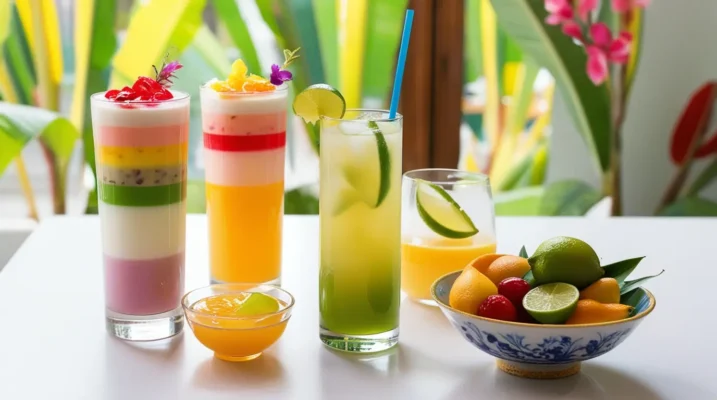
Your foodie vietnam adventure extends beyond savory dishes and coffee. Vietnam offers delightful refreshing drinks and unique desserts. These provide sweet or cooling counterpoints to rich main meal flavors. EssentialVietNamtravel.com encourages exploring these. They are integral to the culinary landscape. From fresh juices to local beers and sweet soups, there is much to discover.
These treats are at street stalls, markets, and dessert shops. Trying them rounds out your Vietnamese gastronomy understanding. This section introduces popular choices. Leave room for these delightful finales or refreshing pick-me-ups. These are part of the overall Dining experience.
Refreshing Beverages Beyond Coffee and Sweet Vietnamese Desserts (Che)
Besides coffee, Vietnam has many refreshing drinks. Bia Hoi is a popular local experience. It is fresh, light draft Fresh Beer. Brewed daily, low alcohol content. Bia Hoi stalls are social spots, very affordable. Fresh sugarcane juice (nuoc mia) is common. Often mixed with calamansi. Fruit juices and smoothies are widely available. Try passionfruit, mango. Young coconut water is refreshing. Herbal teas (tra) are popular.
These drinks suit Vietnam’s climate. Vietnamese desserts, Che, are diverse. Che refers to sweet soups, puddings, beverages, hot or cold. Ingredients include beans, jellies, tapioca, fruits, coconut milk. Popular Vietnamese Dessert Example: Che Ba Mau (three-color dessert), Che Chuoi (banana), Che Bap (corn). These are not overly sweet, offering mixed textures. Find Che stalls in markets. Trying Che is fun culinary exploration for any foodie vietnam. It’s a sweet way to experience local flavors. These treats are a delightful aspect of Southeast Asian cuisine.
Essential Tips for Every Foodie Vietnam Traveler
Embarking on a foodie vietnam adventure is exciting. Planning and knowledge make your culinary journey smoother. EssentialVietNamtravel.com offers practical tips. This section covers trip planning, navigating dietary needs, and learning food phrases. We touch on sharing experiences through Food blogging. These insights help make the most of your time. They empower confident exploration.
Whether seasoned or first-time visitor, these suggestions enhance your quest for Authentic Vietnamese food. Local knowledge enhances food discovery. These tips provide that. This helps find food recommendations and Plan culinary travel. Learning about Vietnamese food culture is part of the journey.
Planning, Picky Eaters, and Dietary Considerations
To maximize your foodie vietnam experience, plan ahead. Research Regional specialties. Decide visit areas based on culinary offerings. If you love Bun Cha, prioritize Hanoi. For unique street food Da Nang is great. Consider trip timing. Some fruits or dishes are seasonal. Book accommodations near food markets. List must-try dishes, but leave room for discoveries. Food tours and cooking classes can be booked. Read blogs like EssentialVietNamtravel.com.
Vietnam can accommodate dietary needs, but communication is key. If a Picky eater or Non-adventurous eater, start with milder dishes. Pho and Banh mi are good entries. Vegetarian Vietnamese recipes are plentiful. Look for “quan chay” (vegetarian eateries). Learn “an chay” (I eat vegetarian). Specify “khong nuoc mam” (no fish sauce) if needed for Fermented products. A Western food purist might find it challenging but freshness often appeals.
Essential Phrases and Sharing Your Culinary Journey
Knowing basic Vietnamese phrases enhances foodie vietnam interactions. “Xin chao” (Hello). “Cam on” (Thank you). “Ngon qua!” (Delicious!). “Cho toi mot…” (Give me one…) then dish name. “Bao nhieu tien?” (How much?). “Tinh tien” (Bill, please). “Khong cay” (Not spicy). Learning these shows respect. It makes ordering easier. Sharing your foodie vietnam discoveries is rewarding.
If you enjoy writing or Food photography, consider Food blogging or social media. Document favorite dishes, Restaurant reviews, Street food finds. Your experiences inspire others. Being a Vietnamese food blogger informally connects you with food enthusiasts. Be respectful taking photos. Sharing your journey aids global appreciation of Vietnamese gastronomy. Your finds help others Discover recipes or locate specific dishes. Sharing food is cultural, and sharing your experiences extends that.
Conclusion: Your Lifelong Foodie Vietnam Memories
Your journey through Vietnam’s flavors will be a travel highlight. From the first Pho bowl to the last sweet Che, the foodie vietnam experience is rich, diverse, and satisfying. EssentialVietNamtravel.com hopes this guide inspired you. We trust it equipped you to explore Vietnamese cuisine with confidence. The balance of five flavors, fresh herbs usage, vibrant Street food culture, and Vietnamese warmth create an unforgettable culinary adventure.
Vietnamese food is delicious. Authentic experiences are valuable. Sharing food is cultural. Trying new food is adventurous. Embrace it all. Go forth, taste, explore, and create delicious memories in Vietnam. EssentialVietNamtravel.com is here for your next adventure. This Culinary travel will leave you a seasoned Vietnam food enthusiast.
Further Reading: Dive Deeper into Vietnamese Cuisine
- A Delicious Journey Through Vietnamese Flavors, Dishes & Culture (https://essentialvietnamtravel.com/2025/04/19/vietnam-food-delicious-journey-flavors-dishes-culture/)
- Discover the Absolute Best Food of Vietnam You Must Try (https://essentialvietnamtravel.com/2025/04/30/best-food-of-vietnam/)
- Retracing Anthony Bourdain’s Iconic Vietnam Food Journey (https://essentialvietnamtravel.com/2025/05/03/anthony-bourdain-and-vietnam-food-journey/)
- What Food to Prepare for a Visitor from Vietnam? (https://essentialvietnamtravel.com/2025/05/17/what-food-to-have-for-a-visitor-from-vietnam/)

